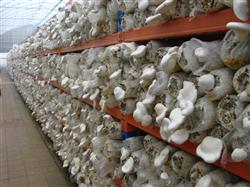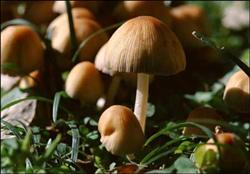Summer cultivation of straw mushrooms is timely

Volvariella volvacea is a kind of high-temperature mushroom, which is suitable for cultivation in summer. It has tender meat, delicious taste, high nutritional value, and is rich in protein, sugars and vitamins. Among many edible fungi, volvariella volvacea has the simplest cultivation method, the shortest production cycle (about 20 days), the most abundant raw materials and the most delicious taste. Its products, whether fresh mushrooms, dried products, or canned, in domestic and foreign markets, are deeply loved by the majority of consumers. The temperature range of mycelium growth of volvariella volvacea is 3039 ℃, the most suitable temperature is 36 ℃, the air relative humidity is 800.85%; the temperature range of fruiting body growth is 223.34 ℃, the most suitable temperature is 30 ℃, the air relative humidity is 855.95%, and the suitable temperature in culture material is 323.38 ℃. 1. The sandy loam soil with good ventilation, convenient water supply, easy drainage and rich organic matter is selected as the cultivation site. Remove weeds, turn the soil and loosen the soil, and spray thick lime water to kill pests in the soil. Make an east-west border, 1 meter wide and unlimited in length. Trenches are dug around the bed for drainage and irrigation. Bamboo sheets are used on the border to build an arch shed with a height of 0.7 to 0.8 meters. The shed is covered with plastic film, and the plastic film is pressed around with soil. Second, there are many culture materials suitable for the growth of volvariella volvacea, and the cottonseed shell is the best. The formula is: cottonseed hull 95%, lime 5%, adding water 1.8 times the weight of dry material. Before cultivation, the culture materials should be evenly mixed according to the requirements of the formula and fermented for 5 to 7 days. The fermentation method is as follows: mix the material with water and pile it into a long pile with a width of 1 meter and a height of about 60 to 70 centimeters, with no limit on length, and a small amount can also be piled into a round pile. Punch oblique holes around both sides of the pile with sticks 3 to 4 cm in diameter to the bottom of the stack, with a spacing of 10 cm for ventilation. A thermometer is inserted into the stack to observe the stack temperature. After 2-3 days, the reactor temperature can rise to more than 55 ℃. At this time, the pile can be turned for the first time. The method of turning the pile is to turn the internal material to the outside, and then turn the external material to the inside, and then ferment it. After one day, the temperature of the material rises again to about 60 ℃, and then turns the pile again. Generally, the purpose of full fermentation can be achieved by turning the pile for 3 times. Third, spread material sowing to transport the fermented cottonseed shell to the border bed, arranged in a wavy style, about 30 cm wide a wave, wave height 12 cm 14 cm, wave valley depth 1 cm 1.5 cm. The sowing method can be stratified sowing, hole sowing or mixed sowing, and the sowing amount on the top layer should be large, preferably accounting for 50% of the sowing amount. Then cover the plastic film on top, and then cover the straw curtain on the plastic film on the small arch shed. Fourth, management measures ⑴ pay attention to heat preservation. When the temperature is low, uncover the grass curtain at about 10:00 in the sunny day, cover the grass curtain at about 4 o'clock in the afternoon to keep warm, and do not uncover the grass curtain on rainy and windy days. It is necessary to cool down properly when the temperature is hotter. When it is hot, you can not uncover the grass curtain at noon, you can only open it sooner or later. In short, it should be noted that the temperature in the material generally can not exceed 40 ℃, the temperature of the material table generally can not exceed 36 ℃; when the material temperature is low, it should be kept as warm as possible, the material temperature should not be lower than 30 ℃. ⑵, pay attention to moisturizing. If the temperature is dry and the soil and culture materials are too dry, it is best to add water at noon to make the soil moist. The water surface in the ditch is below 1 cm at the bottom of the border, and the general water temperature should not be too low, preferably 28-35 ℃. ⑶, pay attention to ventilation. Ventilation is carried out in combination with the inspection temperature every day, and the ventilation is increased after sowing for 3-5 days. Generally, the four corners of the plastic film are opened and ventilated twice, about 1 hour each time. ⑷ cover soil. After sowing for 5-7 days, the hyphae grew all over the border bed, at this time, clean and fertile vegetable garden soil should be selected to cover the soil. The soil layer is controlled at 1 cm to 1.5 cm thick. The water content of the soil should be controlled in the degree to which the hands can be pinched into a mass and released and dispersed. After covering the soil, it is still necessary to cover the film, and then lift the film after the mycelium grows on the soil layer. 5. Mushroom production management begins to produce mushrooms when the mycelium is twisted. Should pay attention to temperature control and moisturizing, generally can not be directly watered, mainly through irrigation into the ditch to make the soil moist, culture materials to absorb water, in order to meet the needs of the growth and development of mushroom buds; to uncover the curtain and scatter light to facilitate the development of mushroom body. 6. timely harvest when the straw mushroom body grows to the shape of the egg before the membrane is broken, too late harvest will easily cause the mushroom body to open the umbrella and reduce the commodity value. It is difficult to keep straw mushrooms fresh after harvesting. In the high temperature season of more than 30 ℃, the umbrella opening rate can reach about 50% after 4-5 hours of egg harvest, so it should be dealt with in time. The fresh ones should be put on the market as soon as possible, and the cans should be processed in time.
- Prev

New techniques for bag cultivation of Pleurotus ostreatus
1. After ripening, the mycelium of Pleurotus ostreatus can not produce mushroom immediately after the mycelium grows full, it needs to go through 50-60 days of physiological maturity to produce mushroom. At this stage, the temperature should be controlled at 20-25 ℃, if the temperature is low, the time should be extended, the air relative humidity should be increased to 75%, and a certain amount of light should be increased. 2. The mycelium of Pleurotus ostreatus is about to reach.
- Next

How to prevent straw mushroom from becoming red mushroom disease?
"Red mushroom disease" may be brown rot, also known as vesicle disease, wet bubble disease and so on. Mainly harmful to mushrooms, straw mushrooms, Pleurotus ostreatus and so on. The disease is caused by a pathogen called verrucosporium. The main symptoms are as follows: the conidia and conidia of verrucosporium only infect the fruiting body, but not the mycelium. When the fruiting body is slightly infected.
Related
- Fuxing push coffee new agricultural production and marketing class: lack of small-scale processing plants
- Jujube rice field leisure farm deep ploughing Yilan for five years to create a space for organic food and play
- Nongyu Farm-A trial of organic papaya for brave women with advanced technology
- Four points for attention in the prevention and control of diseases and insect pests of edible fungi
- How to add nutrient solution to Edible Fungi
- Is there any good way to control edible fungus mites?
- Open Inoculation Technology of Edible Fungi
- Is there any clever way to use fertilizer for edible fungus in winter?
- What agents are used to kill the pathogens of edible fungi in the mushroom shed?
- Rapid drying of Edible Fungi

